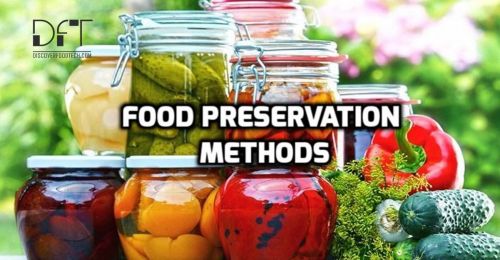METHODS OF FOOD PRESERVATION
- Uses of low temperature (refrigeration, chilling freezing)
- Uses of high temperature (pasteurization, boiling, canning)
- Dehydration (drying under the sun, mechanical drying, freeze drying, smoking)
- Fermentation
- Irradiation
- Chemical preservatives
- Class I preservatives / natural preservatives
- Class II preservatives / chemical preservatives
Uses of low temperature
It used to retard chemical reactions & action of food enzymes & slow down or stop the growth of activities of microorganisms in food.
- Cellar storage (about 15degree centigrade) – root crops, potatoes, onions, apples, etc
- Refrigerator or freezing (0 to 5-degree centigrade) – meat, poultry, fish, milk & milk products, fruits, vegetables, etc.
- Freezing (-18 to -40-degree centigrade) – perishable food like meat, poultry, fish, ice-cream, peas, vegetables, etc.
Uses of High temperature
Food is heated up or cooked. Heat kill microorganisms, alter the protein structures & destroys enzyme activities of microorganisms in food.
- Boiling (at 100-degree centigrade) at home we preferred this process. Cooking of rice, vegetables, meat, fish, etc.
- Pasteurization is a heat treatment that kill a part but not all microorganisms present and usually involves the preparation of temp. Below 100 degree centigrade.
- Low temp holding (LTH) 62 degree centigrade for 30 minutes.
- High temp short time (HTST) or flash method 72 degrees centigrade for 15 minutes.
- Ultra-high temp sterilization (UTHS) 135 degree centigrade for 2 seconds. This method makes food commercially sterile. Such food is packed under aseptic condition & can be stored at room temp for three to six months.
- Canning is the process in which the foods are heated in hermetically sealed (airtight) jars or cans to a temp that destroyed microorganisms & inactivates enzymes that could be a health hazard or causes of food to spoil. Canning is a vacuum-sealed process. Example – tinned food, such as soup, meat, beans, nuts milk, fish, etc.
Irradiation
it is another sterilizing technique in which the foods are bombarded by high –energy rays called gamma rays or by fast-moving electrons to killed bacteria, fungi & insects& in some case s delay fruits ripening. It has been used in pasteurizing or sterilizing perishable food such as meat, fish, fruits & extending their storage lives for long periods.
Chemical preservatives
are also referred to as food additives. It is a substance added intentionally to food, generally in small quantities to improve appearance, flavor, texture or storage properties. Suger, salt, oil, spices, lime juice, etc are the class I preservatives. Benzoic acid, sulfur dioxide, nitrites, etc are the class II preservatives.
Dehydration
it is a process usually accomplished by the removal of water. The dried foods are preserved because the availability of water content is very low that the microorganism cannot grow & enzyme activities are controlled. Example – grapes (raisins), dates, raw mango (amchur), a vegetable like cabbages, cauliflower, etc.



